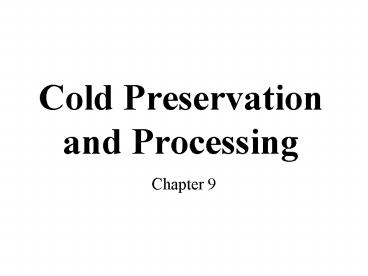Cold Preservation and Processing - PowerPoint PPT Presentation
1 / 24
Title:
Cold Preservation and Processing
Description:
1920's - Clarence Birdseye initiated frozen food packaging. Storage Temperatures ... Some growth at sub-freezing temps as long as water is available ... – PowerPoint PPT presentation
Number of Views:6390
Avg rating:3.0/5.0
Title: Cold Preservation and Processing
1
Cold Preservationand Processing
- Chapter 9
2
Historical Perspective
- 1875 - first mechanical ammonia refrigeration
system invented - 1920s - Clarence Birdseye initiated frozen food
packaging
3
Storage Temperatures
- Cool storage 16 to -2oC (60 to 28oF)
- Refrigerators 4.5 to 7oC (40 to 45oF)
- Frozen storage 0 to -18oC (32 to 0oF)
4
Microbial Growth
- Best above 10oC (50oF)
- Some growth at sub-freezing temps as long as
water is available - Little growth below -9.5oC (15 oF)
5
RefrigeratedStorage
6
Cool Storage Is
- Gentlest method of food preservation
- Few adverse effects on
- Taste
- Texture
- Nutritive value
- Color
- Short time preservation
7
Timeliness of Refrigeration
- ASAP after harvest/slaughter
- Remove heat rapidly through use of
- Moving air
- Hydrocooling
- Vacuum cooling
- Liquid nitrogen
8
Requirement ofRefrigerated Storage
- Low temperatures
- Air circulation
- Humidity control (80 to 95)
- Modified gas atmospheres
9
Factors AffectingCooling Requirements
- Cold storage room insulation
- Frequency of door opening
- Heat load of food product
- Quantity of hot product loaded daily
- Respiration rate of food product
- C6H12O66O2 Þ 6CO26H2Oheat
10
Controlled Atmosphere Storage
- Standard cold storage temperatures humidity
- Reduced O2 levels
- Elevated CO2 levels
- Why?
11
C6H12O66O2 Þ6CO26H2Oheat
12
Types of ControlledAtmosphere Storage
- Drive-in cold storage rooms
- Packaged
- Fruits
- Vegetables
- Meats
- Hypobaric (reduced pressure) storage
- Reduces air (and O2) availability
13
Changes in Food During Refrigerated Storage
- Chill injury
- Flavor/odor absorption
- Loss of
- Firmness
- Color
- Flavor
- Sugar/acid
14
FrozenStorage
15
Initial Freezing Point
- Pure water freezes at 0oC (32oF)
- With dissolved salt, sugar or other components,
water would freeze at - higher temperatures?
- or
- lower temperatures?
16
Initial Freezing Point
- Pure water freezes at 0oC (32oF)
- With dissolved salt, sugar or other components,
water would freeze at - higher temperatures?
- or
- lower temperatures?
17
TRIVIA
- Why is salt added to ice in a ice cream freezer?
- How cold is ice when it begins to freeze?
- How cold will ice get?
18
Freezing Curve
19
Changes During Freezing
- Concentration effects
- precipitation, salting-out, dehydration
- Ice crystal damage
- cell rupture, emulsion disruption
- Slow freeze large ice crystals
- Want a rapid freeze to -18oC (0oF)
20
Intermittent Thawing
- Increases ice crystal size
- Damaged cell very susceptible to enzymatic
degradation
21
Freezing Methods
- Freezing in air
- Still-air sharp freezer
- Blast freezer
- Fluidized-bed freezer
22
Tunnel Freezer
23
(No Transcript)
24
Freezing Methods
- Indirect contact freezing
- Single plate
- Double plate
- Pressure plate
- Slush freezer
- (In all cases, food or food packages are in
direct contact with a surface that is cooled by a
refrigerant)
25
Freezing Methods
- Immersion freezing
- Heat exchange fluid
- Compressed gas
- Refrigerant spray
- Very fast freezing using liquid nitrogen
- IQF Individually Quick Frozen
26
Liquid Nitrogen Spray Freezing Unit
27
Packaging
- Protect against dehydration
- Strong flexible
- Protect against light air
- Liquid tight

